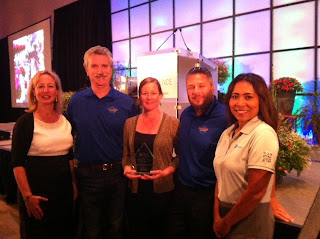EU Voted for a Two-Year Ban on Pesticides Thought to be Harmful to
Bees
A bee
collects pollen from a sunflower in Utrecht, the Netherlands.
British newspaper the Guardian reported this past Monday
that the EU is banning pesticides that are thought harmful to bees. One day
later, the New York Times, Huffington Post, BBC, NPR and many, many others are
all a buzz with the news. “I pledge to do my utmost to ensure that our bees, which are so vital
to our ecosystem and contribute over €22 billion annually to Europeanagriculture, are protected,” said Tonio Borg from the European Commission in
Brussels.
The pesticides in question are called neonicotinoid pesticides. This
nicotine-like chemical is extremely toxic to insects. It dissolves in water,
which means it can be taken up by the roots (or even applied to the seed)
making the entire plant, even the pollen toxic. Worldwide sales of the
pesticides total in the billions of dollars. Bayer CropScience and Syngenta are
the two companies that are making the product in Europe. Both companies point
to colony collapse disorder, mites and viruses, environmental changes and poor
nutrition for the decline in bee populations. And, certainly these things must
be contributing to the problem.
Americans are watching the proceedings and research closely because
the pesticide is in wide use here in the U.S. In another New York Times article
it has been reported by beekeepers that 40-50% of bees have died off in the
past year.
Beekeepers and environmentalists are suing the Environmental
Protection Agency over its approval of the products, which they claim were
allowed on the market with inadequate review.
Bees need you now more than ever. Please take them to heart when you
do your spring shopping. Every plant counts! With thanks to Mid-Atlantic
Gardening, I’d like to share this list of bee favorites.
Salvia nemorosa
‘Caradonna’
The super
dark purple blossoms make a great cut flower besides being bee caviar. Cutting
back the spent flowers will encourage a second bloom for you and your bees.
Monarda
didyma
The bees
will love it and so will you. Use it to decorate summer salads and add color to
homemade herb butters.
Sunflowers
Annual
sunflowers are easy to grow from seed. It’s a fun way to introduce your
children to gardening and the outdoors.
Hollies (Ilex)
Butterfly Bushes (Buddleia
davidii)
Salvia of all sorts (Salvia
greggii, Salvia nemerosa)
Catmint (Nepeta cultivars
like ‘Dropmore’, ‘Six Hills Giant’)
Sedum (especially fall bloomers like ‘Autumn Joy’ and ‘Matrona’)
Mountain Mint (Pycnanthemum)
Veronica (cultivars like ‘Sunny Border Blue’)
False
Aster (Boltonia asteroids)
Asters
Beebalm (Monarda didyma and
its cultivars)
Anise Hyssop (Agastache)
Sunflower (annual or
perennial)
Lavender (Lavandula)
Goldenrod (Solidago)
Bringing Life to your Garden!
Have fun out there, Peggy Anne























